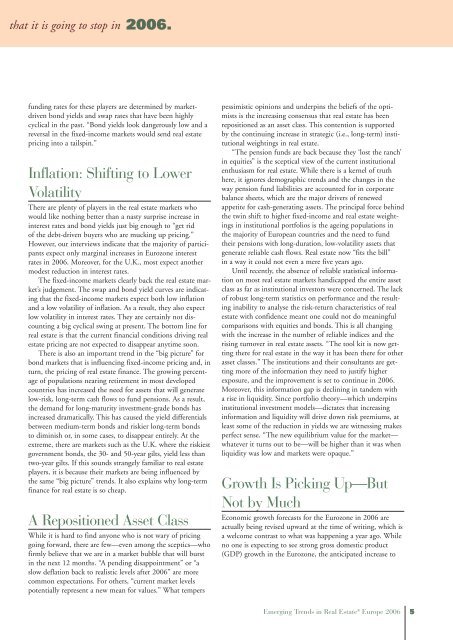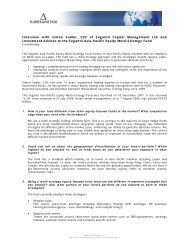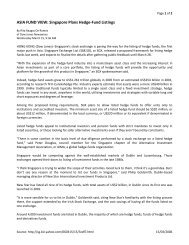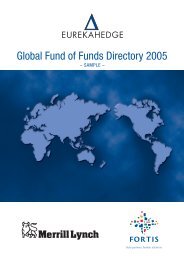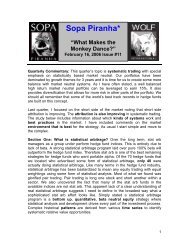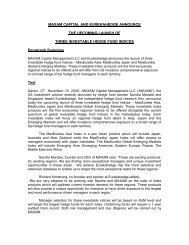Emerging Trends in Real Estate® Europe 2006 - Urban Land Institute
Emerging Trends in Real Estate® Europe 2006 - Urban Land Institute
Emerging Trends in Real Estate® Europe 2006 - Urban Land Institute
You also want an ePaper? Increase the reach of your titles
YUMPU automatically turns print PDFs into web optimized ePapers that Google loves.
that it is go<strong>in</strong>g to stop <strong>in</strong> <strong>2006</strong>.<br />
fund<strong>in</strong>g rates for these players are determ<strong>in</strong>ed by marketdriven<br />
bond yields and swap rates that have been highly<br />
cyclical <strong>in</strong> the past. “Bond yields look dangerously low and a<br />
reversal <strong>in</strong> the fixed-<strong>in</strong>come markets would send real estate<br />
pric<strong>in</strong>g <strong>in</strong>to a tailsp<strong>in</strong>.”<br />
Inflation: Shift<strong>in</strong>g to Lower<br />
Volatility<br />
There are plenty of players <strong>in</strong> the real estate markets who<br />
would like noth<strong>in</strong>g better than a nasty surprise <strong>in</strong>crease <strong>in</strong><br />
<strong>in</strong>terest rates and bond yields just big enough to “get rid<br />
of the debt-driven buyers who are muck<strong>in</strong>g up pric<strong>in</strong>g.”<br />
However, our <strong>in</strong>terviews <strong>in</strong>dicate that the majority of participants<br />
expect only marg<strong>in</strong>al <strong>in</strong>creases <strong>in</strong> Eurozone <strong>in</strong>terest<br />
rates <strong>in</strong> <strong>2006</strong>. Moreover, for the U.K., most expect another<br />
modest reduction <strong>in</strong> <strong>in</strong>terest rates.<br />
The fixed-<strong>in</strong>come markets clearly back the real estate market’s<br />
judgement. The swap and bond yield curves are <strong>in</strong>dicat<strong>in</strong>g<br />
that the fixed-<strong>in</strong>come markets expect both low <strong>in</strong>flation<br />
and a low volatility of <strong>in</strong>flation. As a result, they also expect<br />
low volatility <strong>in</strong> <strong>in</strong>terest rates. They are certa<strong>in</strong>ly not discount<strong>in</strong>g<br />
a big cyclical sw<strong>in</strong>g at present. The bottom l<strong>in</strong>e for<br />
real estate is that the current f<strong>in</strong>ancial conditions driv<strong>in</strong>g real<br />
estate pric<strong>in</strong>g are not expected to disappear anytime soon.<br />
There is also an important trend <strong>in</strong> the “big picture” for<br />
bond markets that is <strong>in</strong>fluenc<strong>in</strong>g fixed-<strong>in</strong>come pric<strong>in</strong>g and, <strong>in</strong><br />
turn, the pric<strong>in</strong>g of real estate f<strong>in</strong>ance. The grow<strong>in</strong>g percentage<br />
of populations near<strong>in</strong>g retirement <strong>in</strong> most developed<br />
countries has <strong>in</strong>creased the need for assets that will generate<br />
low-risk, long-term cash flows to fund pensions. As a result,<br />
the demand for long-maturity <strong>in</strong>vestment-grade bonds has<br />
<strong>in</strong>creased dramatically. This has caused the yield differentials<br />
between medium-term bonds and riskier long-term bonds<br />
to dim<strong>in</strong>ish or, <strong>in</strong> some cases, to disappear entirely. At the<br />
extreme, there are markets such as the U.K. where the riskiest<br />
government bonds, the 30- and 50-year gilts, yield less than<br />
two-year gilts. If this sounds strangely familiar to real estate<br />
players, it is because their markets are be<strong>in</strong>g <strong>in</strong>fluenced by<br />
the same “big picture” trends. It also expla<strong>in</strong>s why long-term<br />
f<strong>in</strong>ance for real estate is so cheap.<br />
A Repositioned Asset Class<br />
While it is hard to f<strong>in</strong>d anyone who is not wary of pric<strong>in</strong>g<br />
go<strong>in</strong>g forward, there are few—even among the sceptics—who<br />
firmly believe that we are <strong>in</strong> a market bubble that will burst<br />
<strong>in</strong> the next 12 months. “A pend<strong>in</strong>g disappo<strong>in</strong>tment” or “a<br />
slow deflation back to realistic levels after <strong>2006</strong>” are more<br />
common expectations. For others, “current market levels<br />
potentially represent a new mean for values.” What tempers<br />
pessimistic op<strong>in</strong>ions and underp<strong>in</strong>s the beliefs of the optimists<br />
is the <strong>in</strong>creas<strong>in</strong>g consensus that real estate has been<br />
repositioned as an asset class. This contention is supported<br />
by the cont<strong>in</strong>u<strong>in</strong>g <strong>in</strong>crease <strong>in</strong> strategic (i.e., long-term) <strong>in</strong>stitutional<br />
weight<strong>in</strong>gs <strong>in</strong> real estate.<br />
“The pension funds are back because they ‘lost the ranch’<br />
<strong>in</strong> equities” is the sceptical view of the current <strong>in</strong>stitutional<br />
enthusiasm for real estate. While there is a kernel of truth<br />
here, it ignores demographic trends and the changes <strong>in</strong> the<br />
way pension fund liabilities are accounted for <strong>in</strong> corporate<br />
balance sheets, which are the major drivers of renewed<br />
appetite for cash-generat<strong>in</strong>g assets. The pr<strong>in</strong>cipal force beh<strong>in</strong>d<br />
the tw<strong>in</strong> shift to higher fixed-<strong>in</strong>come and real estate weight<strong>in</strong>gs<br />
<strong>in</strong> <strong>in</strong>stitutional portfolios is the age<strong>in</strong>g populations <strong>in</strong><br />
the majority of <strong>Europe</strong>an countries and the need to fund<br />
their pensions with long-duration, low-volatility assets that<br />
generate reliable cash flows. <strong>Real</strong> estate now “fits the bill”<br />
<strong>in</strong> a way it could not even a mere five years ago.<br />
Until recently, the absence of reliable statistical <strong>in</strong>formation<br />
on most real estate markets handicapped the entire asset<br />
class as far as <strong>in</strong>stitutional <strong>in</strong>vestors were concerned. The lack<br />
of robust long-term statistics on performance and the result<strong>in</strong>g<br />
<strong>in</strong>ability to analyse the risk-return characteristics of real<br />
estate with confidence meant one could not do mean<strong>in</strong>gful<br />
comparisons with equities and bonds. This is all chang<strong>in</strong>g<br />
with the <strong>in</strong>crease <strong>in</strong> the number of reliable <strong>in</strong>dices and the<br />
ris<strong>in</strong>g turnover <strong>in</strong> real estate assets. “The tool kit is now gett<strong>in</strong>g<br />
there for real estate <strong>in</strong> the way it has been there for other<br />
asset classes.” The <strong>in</strong>stitutions and their consultants are gett<strong>in</strong>g<br />
more of the <strong>in</strong>formation they need to justify higher<br />
exposure, and the improvement is set to cont<strong>in</strong>ue <strong>in</strong> <strong>2006</strong>.<br />
Moreover, this <strong>in</strong>formation gap is decl<strong>in</strong><strong>in</strong>g <strong>in</strong> tandem with<br />
a rise <strong>in</strong> liquidity. S<strong>in</strong>ce portfolio theory—which underp<strong>in</strong>s<br />
<strong>in</strong>stitutional <strong>in</strong>vestment models—dictates that <strong>in</strong>creas<strong>in</strong>g<br />
<strong>in</strong>formation and liquidity will drive down risk premiums, at<br />
least some of the reduction <strong>in</strong> yields we are witness<strong>in</strong>g makes<br />
perfect sense. “The new equilibrium value for the market—<br />
whatever it turns out to be—will be higher than it was when<br />
liquidity was low and markets were opaque.”<br />
Growth Is Pick<strong>in</strong>g Up—But<br />
Not by Much<br />
Economic growth forecasts for the Eurozone <strong>in</strong> <strong>2006</strong> are<br />
actually be<strong>in</strong>g revised upward at the time of writ<strong>in</strong>g, which is<br />
a welcome contrast to what was happen<strong>in</strong>g a year ago. While<br />
no one is expect<strong>in</strong>g to see strong gross domestic product<br />
(GDP) growth <strong>in</strong> the Eurozone, the anticipated <strong>in</strong>crease to<br />
<strong>Emerg<strong>in</strong>g</strong> <strong>Trends</strong> <strong>in</strong> <strong>Real</strong> Estate ® <strong>Europe</strong> <strong>2006</strong> 5


